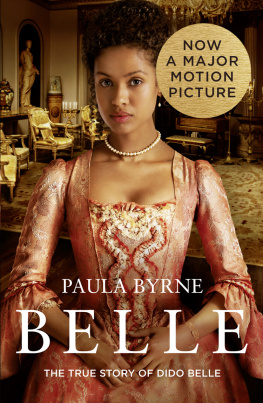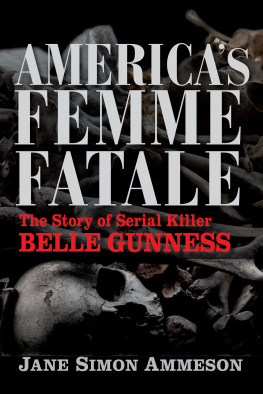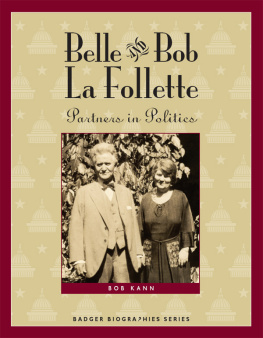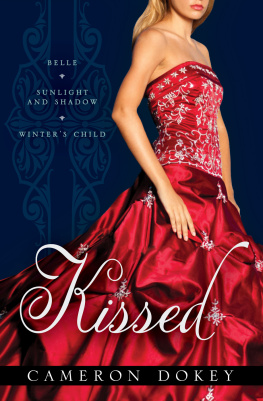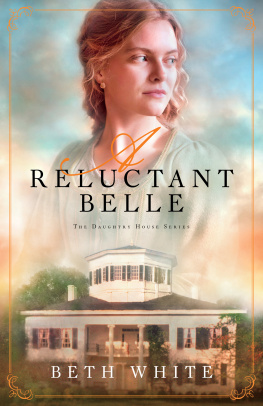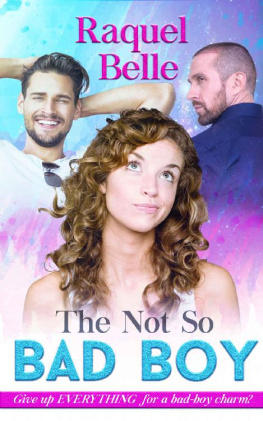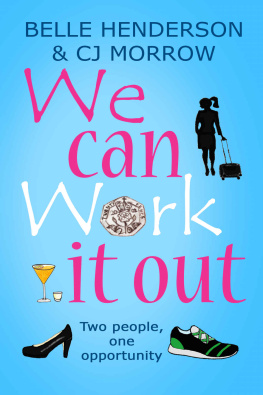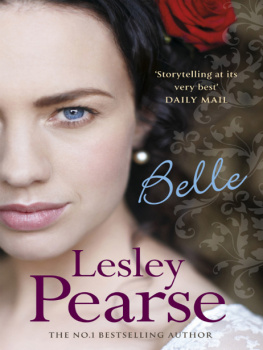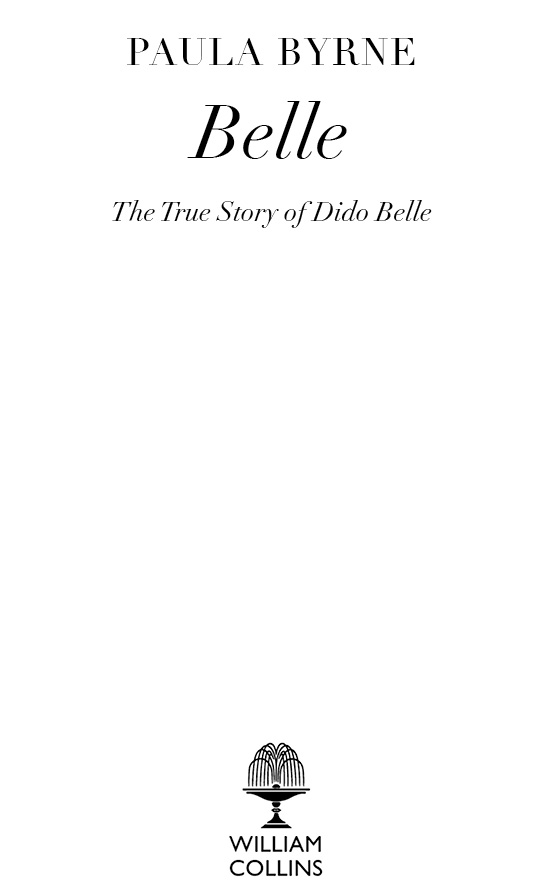The double portrait (By kind permission of the Earl of Mansfield, Scone Palace)
Captain Sir John Lindsay, Didos father (Burrell Collection, Glasgow)
The Abolition of the Slave Trade, by Isaac Cruikshank (Private collection)
Still life with meat, kettle, cup, sugar loaf and sugar lumps, by Jean-Baptiste Oudry (Muse des Beaux-Arts et dArchologie de Besanon/Giraudon/Bridgeman Art Library)
Elevations of the north and south fronts of Kenwood House, and the interior of Lord Mansfields Library, by Robert and James Adam
Lady Mansfield, Didos adoptive mother, by Sir Joshua Reynolds (By kind permission of the Earl of Mansfield, Scone Palace)
Detail from Four Times of the Day: Noon, by William Hogarth (Private collection)
William Murray, by Jean-Baptiste van Loo (Kenwood House, courtesy of English Heritage)
Granville Sharp, by George Dance (Frontispiece to Prince Hoares Memoirs of Granville Sharp, 1820)
Report of the Somerset case (In T.B. Howell, A Complete Collection of State Trials, vol. 20, 1816)
Wedgwood anti-slavery pendant (Kenwood House, courtesy of English Heritage)
The Gordon Riots, 1780 (Private collection)
Caen Wood in Middlesex, Seat of Earl of Mansfield, engraving by James Heath, after a drawing by Richard Corbould (Private collection)
The Zong: slaves being thrown overboard (Courtesy Everett Collection/REX)
Mansfield as Lord Chief Justice, engraving after a portrait by Reynolds (Private collection)
Dido Belle, amanuensis to the Lord Chief Justice (The Honourable Society of Lincolns Inn, by kind permission of the Treasurer and Masters of the Bench of Lincolns Inn)
Anti-Saccharrites, by James Gillray (Private collection)
The marriage of John Davinie and Dido Elizabeth Belle (Westminster City Archive)
Eastwell Park (Private collection)
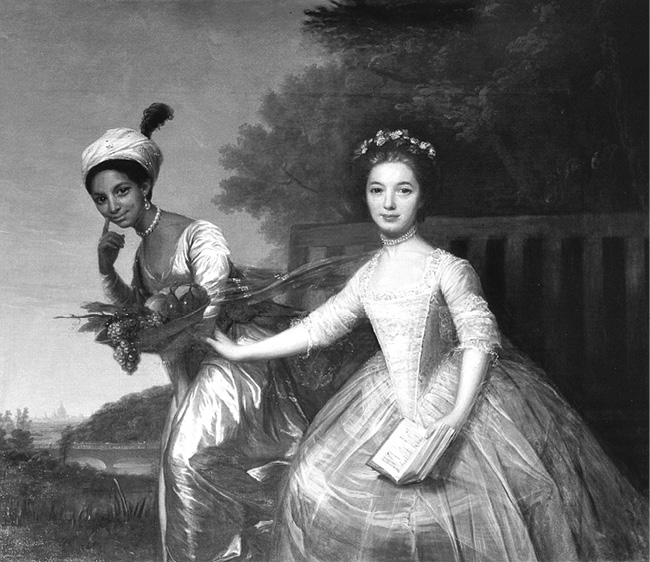
The Double Portrait
A portrait from the late eighteenth century, it depicts two beautiful young girls. The white-skinned, fair-haired one in the foreground sits on a large, green, high-backed bench, and is dressed in pink silk with intricate lace trimmings. She has a garland of pink flowers in her hair and a double strand of pearls around her neck. She is holding a book. She is reaching out to the girl behind her, taking her arm as if pulling her into the frame. She hardly needs to do so, as the eye is drawn irresistibly to this other girl, with the high cheekbones and the enigmatic dimpled smile.
The girl on the left is dressed in sumptuous white and gold satin, and wears a string of creamy large pearls around her neck. She has expensive-looking droplet pear and diamond earrings, and a white and gold bejewelled turban with an ostrich feather perching jauntily at the back. She carries a basket of fruit, and is wearing an exquisite blue and gold sheer shawl which floats in the breeze as she walks. She is in motion, bursting with vitality and energy. Her knee is bent forward beneath her dress, as if she is about to run as free as the wind. The girl in pink, by contrast, sits still.
The standing girl rests a forefinger quizzically on her cheek as she gazes confidently at the artist. She almost seems to be sharing a confidence. In the conventions of portraiture, a pointing figure may denote a mystery, an enigma, a secret withheld. That may well be the case here, given the knowing look that goes with it. But the gesture also says, Look at me. Look at the colour of my skin. It is as if she is asking, Who am I? And what am I, a black girl, doing here?
The artist must have known that it was an unusual commission. The double portrait has a long and distinguished tradition. Typically, the subject would be a husband and wife, a mother and child, or a pair of sisters. In its composition, this portrait conforms to the model for representing a pair of sisters. One could readily imagine the sitting girl as an older sister, studious, conventional and full of good sense. And the standing one as a younger sister, with a little bit of wildness or rebellion about her, and a great deal of passion of sensibility, as they would have said in the eighteenth century. The rarity, however, comes from the colour of their skin. This is, as far as we know, the only portrait of its era to show a white girl and a black one together in a sisterly pose.
London is in the background. The viewer can readily make out the dome of St Pauls Cathedral. Behind the girls is a garden of mature trees that leads down to a lake with a bridge. The season would appear to be high summer. This is clearly the estate of a wealthy man, of someone who would be proud to show off his daughters. A double portrait of this kind was often painted to commemorate a special occasion a birthday, a coming of age perhaps, or a party or event held on the estate in the summer months when the gardens were at their very best. But surely if a wealthy man in eighteenth-century England really did have one daughter who was white and another who was black, he would have been ashamed of the fact? There would have been the stain not only of illegitimacy but, even more shockingly for the time, of inter-racial sex. You would have thought that the black girl would be concealed below stairs, not celebrated in a large portrait. To a contemporary viewer, the image would have been startling: a black girl, expensively dressed, and on an almost equal footing with her white companion.
Almost equal, because the white girl occupies the foreground of the painting. But the viewer is left with little doubt that it is the black girl who has captured the imagination of the artist. She is dressed in an exotic style, bearing colours that give the painter the opportunity to show off the full range of his palette. The dress, though as expensive and beautiful as the white girls, signals her difference. The sheer shawl looks Indian, as do the turban and feather. Intriguingly, a tartan or plaid shawl is tied around her waist. Could she have Scottish heritage?
The white girl is made to look demure the wreath of rosebuds in her hair suggests virginity while her black companion sports one of the most fashionable accessories of the day: an ostrich feather, as popularised by the leading fashion icon of the era, Georgiana, Duchess of Devonshire. Georgiana created her first great stir in 1775, when the British Ambassador in Paris, Lord Stormont, presented her with a four-foot-long ostrich feather, which she contrived to incorporate within a spectacular hairdo. From then on, every fashionable lady wanted an ostrich feather to the extent that the poor bird was hunted almost to extinction in North Africa. Lord Stormont was the father of the white girl in the picture.
The language of painting in the eighteenth century was heavily symbolic. The basket of exotic produce points to the black girls foreign background, with the ripe fruits grapes and figs and peaches suggesting her lusciousness. At a literal level, she is carrying fruit that she has picked in the orangery or the hothouse for the dinner table of the big house. But at a metaphoric level she is herself being compared to a sweet foreign fruit flourishing on English soil (a wealthy man with an orangery or glasshouse could grow his own pomegranates and pineapples, but even a middle-ranking householder who was prepared to pay could go to Covent Garden market and buy exotic produce that had been cultivated in the Tarring Fig Gardens of Sussex). The grapes are a mix of black and white, happily entwined in what could be an allusion to some close bond between the girls. Though so physically different, could they share some of the same blood?

